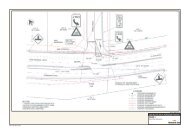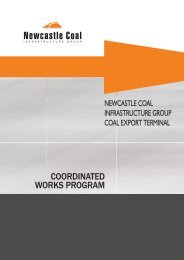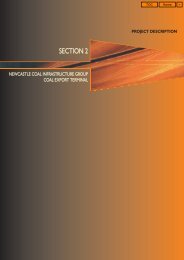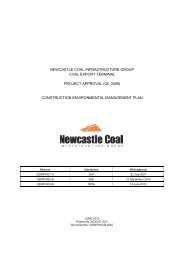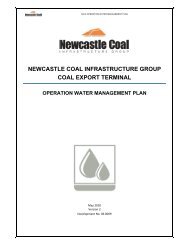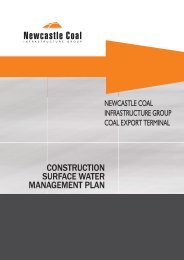Stage 2F Acid Sulphate Soils Management Plan - Newcastle Coal ...
Stage 2F Acid Sulphate Soils Management Plan - Newcastle Coal ...
Stage 2F Acid Sulphate Soils Management Plan - Newcastle Coal ...
- No tags were found...
Create successful ePaper yourself
Turn your PDF publications into a flip-book with our unique Google optimized e-Paper software.
<strong>Acid</strong> Sulfate Soil <strong>Management</strong> <strong>Plan</strong>3.2.2 Surface Water <strong>Management</strong> InfrastructureA network of stormwater drains, primary and secondary settling ponds and an overflow pond will be used tomanage runoff on and around the site. All site water management structures are lined with low permeabilitymaterials (e.g. compacted clay or geo-membrane) to minimise the potential for leakage.All excavations required for the construction of Project surface water management infrastructure are undertakenin accordance with procedures described in Section 3.4.3.3 POTENTIAL ACID SULFATE SOIL IMPACTSWhere works impact on the existing estuarine soils, there is the potential to disturb ASS and these works willrequire the implementation of the controls detailed in this management plan. Whilst the following informationrelates to specific activities, all activities that disturb estuarine soils will be assessed for acid generating potentialand treated accordingly.Project elements have been designed to minimise excavations. As described in Section 3.2, limited excavationswill be required during the construction of <strong>Stage</strong> <strong>2F</strong> of the Project. These excavations have the potential tointercept ASS.Any activities (e.g. excavations or groundwater extraction) that have the potential to lower the water table mayenhance the oxidation of sediments. Where excavation is below the water table and into the estuarine soils,drawdown on the water table is possible which may expose PASS soils. This can result in exposure of previouslysaturated sediments allowing oxidation of PASS and acid generation.It is expected that the groundwater table will recover to within the vicinity of its original level after backfilling.3.4 ACID SULFATE SOIL MANAGEMENT STRATEGYPrior to any excavation on-site, a representative surface and sub-surface soil sampling and analysis program willbe undertaken in order to characterise the material to be excavated. The sampling program will be undertaken inaccordance with the <strong>Acid</strong> Sulfate Soil Manual (ASSMAC, 1998). A description of the sampling program isprovided in Section 3.4.1.3.4.1 Sampling ProgramThe sampling program will be conducted in accordance with the <strong>Acid</strong> Sulfate Soil Manual (ASSMAC, 1998) priorto any excavation that will extend into the natural soil profile. A sampling program will be developed for eachProject element described in Section 3.2 as follows:foundations for the third berth;development of surface water management infrastructure including temporary re-profiling of land forconstruction purposes.The sampling intensity (i.e. number of samples, depth and sample size) will be as required in the <strong>Acid</strong> Sulfate SoilManual (ASSMAC, 1998) for the area and volume of each excavation.3.4.2 Assessment CriteriaThe NSW <strong>Acid</strong> Sulfate Soil <strong>Management</strong> Advisory Committee (ASSMAC), <strong>Acid</strong> Sulfate Soil Manual (1998),presents guidelines for the sampling, determination and management of ASS materials dependent on the quantityof material to be disturbed and the type of disturbance (linear, bulk). The guidelines provided in the <strong>Acid</strong> SulfateSoil Manual (ASSMAC, 1998) are considered appropriate for use at the Project site.The <strong>Acid</strong> Sulfate Soil Manual (ASSMAC, 1998) outlines ‘Action Criteria’ based on laboratory analysis of ASScharacteristics. These Action Criteria are based on the soil texture together with the volume of material which isto be disturbed to determine if the material is to be managed as an ASS. The Action Criteria provided in Table 3can also be used to assess ‘neutralisation’ of lime treated soils.9




